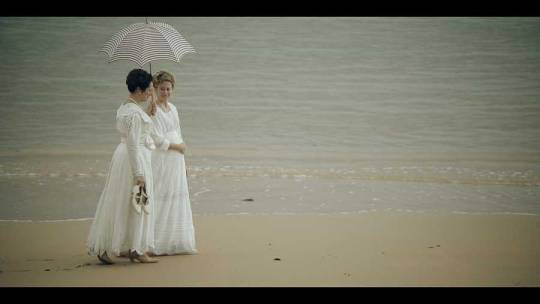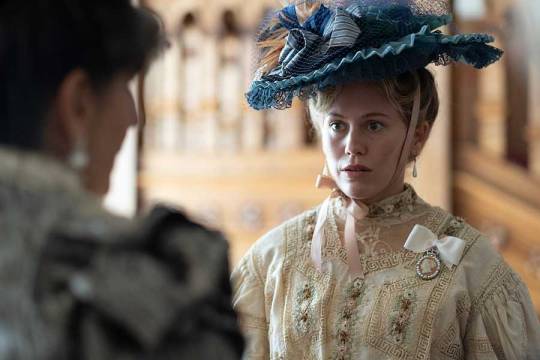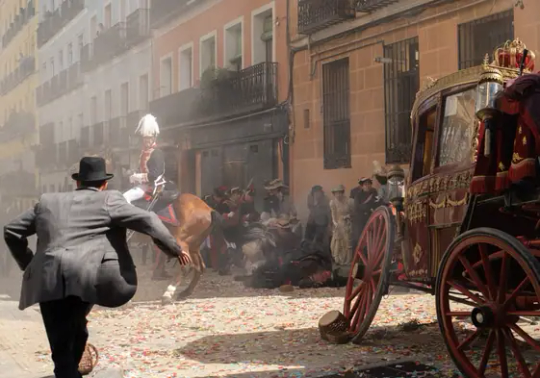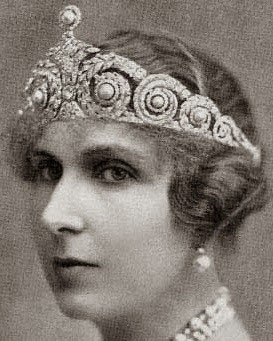#king alfonso xiii of spain
Text

King Alfonso XIII of Spain at the Camp de Châlons military camp in 1905
French vintage postcard
#tarjeta#chlons#postkaart#sepia#the camp de châlons#military#1905#spain#camp#king#carte postale#ansichtskarte#briefkaart#photo#photography#xiii#postal#postkarte#vintage#alfonso#french#postcard#historic#alfonso xiii#ephemera
5 notes
·
View notes
Text

Rare photo of the two daughters of King Alfonso XIII of Spain and Princess Victoria Eugenie of Battenberg, Infantas Beatriz and Maria Christina, 1910s
#so cute!!!#🤍🤍🤍#spanish royal family#infanta Beatriz#infanta Maria Christina#Infanta Beatriz of spain#Infanta Maria Christina of spain#Rares#rare#1910s#favs#king Alfonso xiii#queen victoria eugenie of spain
27 notes
·
View notes
Text
Leonor to Catherine of Aragon. House of Borbón to House of Trastámara.
#credits to the rightful owners#house of borbón#House of Trastámara#spanish royal family#princess leonor#king felipe vi#Juan carlos I#infante juan count of Barcelona#king Alfonso xiii#king alfonso xii#queen isabella ii of spain#king Ferdinand VII#Charles IV of Spain#Charles III of Spain#Philip V of Spain#Luis grand dauphin#Maria Theresa of Spain#Philip IV of Spain#Philip III of Spain#Philip II of Spain#Charles V of Spain#juana i of castile#catherine of aragon
10 notes
·
View notes
Text

Manuel II, King of Portugal, in Paris with Alfonso XIII, King of Spain, the two youngest sovereigns in Europe, front cover illustration from 'Le Petit Parisien', supplemnet litteraire illustre, 5th December 1909 (photolitho)
French School
#dianthus#carnation#portrait#1900s art#1900s fashion#Manuel II#King of Portugal#Alfonso XIII#King of Spain
3 notes
·
View notes
Text


Infantas Beatriz and Maria Christina of Spain, 1920s
They were the daughters of King Alfonso XIII of Spain and Queen Victoria Eugenie of Spain (neé Battenberg)
#infanta Beatriz of Spain#infanta Maria Christina of Spain#spanish royal family#1920s#king Alfonso xiii#queen Victoria Eugenie#princess victoria eugenie of battenberg
13 notes
·
View notes
Text
King Alfonso XIII and Victoria Eugenie, Queen of Spain (known as Ena)
Prince Alfonso (the eldest son of Spain's King Alfonso) married Cuban commoner, Edelmira Sampedro Ocejo y Robato, in Lausanne. Due to her status, none of his family attended the wedding.

#postcards#old postcards#King Alfonso XIII#Queen Victoria Eugenie#king and queen of spain#spanish royalty#circa 1906#prince alfonso#Queen Ena
8 notes
·
View notes
Photo

6 notes
·
View notes
Text

Nine European Sovereigns at Windsor Castle for the funeral of King Edward VII of the United Kingdom (Photo courtesy of Royal Collection Trust) | May 20, 1910
Standing (left to right): King Haakon VII of Norway, King Ferdinand of Bulgaria, King Manuel of Portugal, Emperor William II of Germany, King George I of the Hellenes, King Albert of the Belgians
Seated (left to right): King Alfonso XIII of Spain, King George V, King Frederick VIII of Denmark
#royaltyedit#theroyalsandi#george v#king george v#king george v of the united kingdom#haakon vii of norway#king ferdinand of bulgaria#king manuel of portugal#king william ii of germany#king george of hellenes#king albert of the belgians#king alfonso xiii of sapin#king frederick viii of denmark#british royal family#my edit
76 notes
·
View notes
Text

RTVE is making a new show about Queen Victoria Eugenie of Spain called 'Ena' and I'm pretty impressed with the jewelry so far. This is meant to be Ena on her wedding day in 1906 presumably before the bomb went off. The show is being made by Javier Olivares who also made 'Isabel' about Queen Isabella I of Castile and is currently filming so it won't be out for a while. The jewelry used in shows and movies is never going to look exactly like the real thing unless they spend a ton of their budget on it which isn't going to happen but I appreciate it when they at least try to replicate jewels correctly.

Queen Ena's Fleur de Lys Tiara or as it's commonly called La Buena was made by Ansorena in 1906 as a wedding gift from her husband, King Alfonso XIII of Spain. It has become the most important tiara in the Spanish collection and is now worn by Queen Letizia.
118 notes
·
View notes
Text

“I feel like if King Alfonso XIII would’ve successfully helped the Romanovs seek refuge in Spain like he planned both his and Tsar Nicholas II’s descendants would’ve been pretty close like how the Spanish RF is with the Bulgarian RF. But sadly Alfonso’s plan didn’t work :(” - Submitted by Anonymous
12 notes
·
View notes
Note
Hello! Centuries after Jewish people were expelled from Portugal and Spain, Portugal allowed them to return, but I don't know if Spain did the same. I read your post about Jews in Catalonia, and was wondering if some came back and if there is still a Jewish comunity there today? :o
Yes, the same happened, but they are still few in number.
Some Jewish people returned to Iberia in the 20th century. It might come as a surprise to many, but it was during the proto-fascist dictatorship of Primo de Rivera and during the fascist dictatorship of Francisco Franco when more Jewish people moved to Spain.
Philosephardism became popular in the early 1900s. That's when the first campaigns to bring Sephardi people close to Spain started, many of them led by the politician Ángel Pulido Fernández.
The first campaign was in 1904, but it was more about creating shared organizations with Sephardis in Northern Africa and not so much migration yet. In 1910, the King of Spain Alfonso XIII founded the Spanish-Hebrew Union (Unión Hispano-Hebrea), which saw 4000 people sign up as members in the Moroccan protectorate (remember that at this time Morocco was a protectorate of Spain). This Union created schools for Sephardi children in Morocco and the Balkans to teach them Spanish.
The moment where many Jewish people migrated to Spain, creating a significant Jewish community for the first time since the Middle Ages, was during the First World War (Spain was neutral in WW1, so it was a safe area compared to most of Europe). Barcelona was one of the places that received the most Jewish immigration in this period: about 1,000 people, most of them coming from Austria-Hungary and some from France.
More continued to migrate to Spain during the Primo de Rivera dictatorship (1923-1930), because in 1924 the dictatorship made a law that all Sephardi people could get the Spanish nationality. According to the Comunitat Israelita de Barcelona (the association of Jewish people of Barcelona), in 1936 there were already 5,000 Jewish people, more than half of them newly arrived from Poland and Germany, and others having arrived from Austria, Hungary and Romania.
As expected, the immigration continued during the Second World War, escaping the Holocaust (even though Spain gave support to the Nazis and sent some legions to fight against Russia on Germany's side, it was mostly neutral in WW2 because the Spanish Civil War had just ended, leaving the country in extreme poverty and destruction). The regime said that they were only allowing the Jewish people to cross Spain on their way to somewhere else and that they didn't want them to stay, but after all they weren't really checking on each person, so some stayed.
Even with this situation, make no mistake: Jewish people were not well seen during the dictatorships. It was mandatory to be Catholic, and everything bad in the world was attributed either to the "separatist reds" (national minorities, independentists, communists, anarchists, anticlericals, atheists) or to a "Judeo-Masonic conspiracy" (Jewish people and Freemasons), thought to be working together to destroy Spain and the Christendom. This wasn't just a matter of the early years, no: it was a constant reasoning during the whole dictatorship in the schools, media, speeches, everything. Even in Franco's very last public appearance (October 1st 1975, celebrating his 39th anniversary since he was "appointed" as dictator, when the last week there had been demonstrations in different places around Europe against the death sentence that the regime had condemned some political dissidents to), he blamed the eternal communist, Freemason, Jewish international conspiracy for those demonstrations.
Despite their antisemitism, after the Second World War the fascist dictatorship of Spain also used the fact that they were "helping" Jewish people as a propaganda point to get the sympathy of Western countries, as a way to show that they had sided with Hitler and Mussolini because of a common hatred of communism but not because they hate Jewish people. This way, the dictatorship hoped to be accepted as a normal country, join the UN, with no sanctions. And it worked, mostly because the USA was promoting fascist countries as a way to counter communism.
In the late 1940s, the dictatorship allowed private individual worship to any religion (you could pray to whoever in your private home), even though everyone still had to take part in the Catholic rites in public. In 1949, Franco officially recognised the Barcelona Israelite Community, who opened a synagogue in Barcelona in the year 1954. This was the first synagogue in all the state of Spain since the Jewish people were expelled or forced to convert in 1492.
In the 1950s, the biggest Jewish immigration wave to Spain arrives from Northern Africa, and in the 1960s from South America. In 1968, the Vatican and Spain symbolically revoked the 1492 decree of expulsion. After the end of the dictatorship (1977), there is freedom of religion in Spain.
Nowadays, there is a small but existing Jewish community resulting of these waves of immigration throughout the 20th century. They are only a few thousands, so it doesn't show up in any religion statistics, but they are there.

Percentage of the Spanish population that identifies with each religion. Data from Observatorio del Pluralismo Religioso de España.
#ask#història#religió#jueus catalans#religions#history#20th century history#jewish#spain#european history#history of religion#franquismo#ww1#ww2
33 notes
·
View notes
Photo

My goal is never to copy. Create a new style, clear luminous colours and feel the elegance of the models.
- Tamara de Lempicka (1898-1980)
The painter Tamara de Lempicka was nicknamed ‘the baroness with a paintbrush’. In the années folles between the two World Wars, she flitted between the Ritz Hotel in Paris and the Grand Hotel in Monte Carlo, socialising with - and capturing on canvas - her era’s elite. She counted Queen Elizabeth of Greece, King Alfonso XIII of Spain, and the Italian poet-prince Gabriele d’Annunzio among her sitters. As Jean Cocteau put it, Lempicka ‘loved art and high society in equal measure’.
She was renowned for an Art Deco style which oozed cool chic and elegant sensuality. Portraiture was her genre, featuring stylised subjects bedecked in seductive textures and bathed in flattering light. For some works, Lempicka used herself as model, which made sense given she wore clothes by Coco Chanel and was occasionally mistaken in public for Greta Garbo. ‘Among a hundred paintings,’ she claimed, ‘you could always recognise mine’.
#lempicka#tamara de lempicka#quote#polish#artist#french#paris#parisian#art deco#art#style#europe#france#beauty#arts#culture
119 notes
·
View notes
Text








Upcoming series: Ena
In September, the filming of Ena began, a biographical series that will focus on the life of Victoria Eugenie of Battenberg, queen of Spain through her marriage to Alfonso XIII between May 31, 1906 and April 14, 1931, after being the monarchy deposed later by the proclamation of the Second Republic. Great-grandmother of the current king Philip VI of Spain, of whom she was godmother at his baptism. Throughout six chapters, the series will tell the life of Victoria Eugenie and at the same time offer a portrait of a time that changed the world, the first half of the 20th century, from 1905 to 1945. Born on October 24, 1887 in Aberdeenshire, Scotland, Ena was the daughter of Henry of Battenberg and Princess Beatrice, youngest daughter of Queen Victoria of the United Kingdom and Prince Albert of Saxe-Coburg and Gotha. Her godmother was Eugenia de Montijo, empress consort of France as Napoleón III's wife. The name of the series comes from what her friends and family called her since she was little, Ena.
The fiction is based on the novel of the same name by Pilar Eyre. Javier Olivares, who was behind the acclaimed Isabel and El Ministerio del Tiempo, will be the showrunner and plot manager for Ena. In addition to Olivares, the script is written by Isa Sánchez, Daniel Corpas and Pablo Lara Toledo. The series will be directed entirely by women: Anaïs Pareto, director of the series as a whole, in addition to four episodes, and Estel Díaz, who will direct two episodes.
“Ena is the portrait of historical moments that seem distant but are not so far away, because without them we would not understand the times we live in now,” Olivares declares in the press release sent by TVE. The writer and screenwriter remembers that Victoria Eugenie “fought to be happy in a bitter time, in which she witnessed two world wars, a civil war and a great pandemic, the tortuously called Spanish flu.”
For Pilar Eyre, author of the novel, she was "an extraordinary woman: cultured, supportive, liberal-minded, modern and very loyal." And she is excited because "finally all Spaniards can know" the story of a "misunderstood" woman. in their time, which they will always consider foreign." It is a fiction co-produced by RTVE with Ena La Serie AIE, La Cometa TV and Zona App. José Pastor, director of Film and Fiction at RTVE, has pointed out that "it is a "RTVE is proud to be able to portray this interesting historical character, from the point of view of two women directors and with Javier Olivares as showrunner, in one of its best series."
The Spanish actress of Anglo-Danish descent Kimberly Tell will play Ena and Joan Amargós will play Alfonso XIII. For her part, Elvira Mínguez will play Maria Christina von Habsburg-Lothringen, mother of Alfonso XIII. The cast is completed by Lucía Guerrero (Beatrice of Saxe-Coburg and Gotha), Raúl Mérida (Alfonso of Orleans and Bourbon), Juan Gea (Álvaro Figueroa y Torres, Count of Romanones), María Morales (María del Carmen Angoloti y Mesa, Duchess of Victoria), Pedro Mari Sánchez (Rodrigo de Saavedra y Vinent, Marquis of Villalobar), Luisa Gavasa (Eugenia de Montijo) and Joaquín Notario (José de Saavedra y Salamanca, Marquis of Viana)
Mariano Peña will play Miguel Primo de Rivera; Jaume Madaula will play the anarchist Mateo Morral, author of the attack committed at the royal wedding; Tomás del Estal will be Emilio María de Torres y González-Arnáu, and Ángel Ruiz will once again give life to Federico García Lorca, a character he already played in El Ministerio del Tiempo, among others.
The series will be filmed entirely in natural exteriors and interiors, like the Royal Palace of Madrid, the Palace of La Granja de San Ildefonso (Segovia), the Palace of Santoña (Madrid), the Palace of Fernán Núñez (Madrid), the Fort of San Francisco (Guadalajara) and the Magdalena Palace (Santander), built in 1911 by the City Council as a tribute to the monarchs and where Ena spent a good part of her summers in Spain, accompanied by the Royal Family. Filming for the series will continue until the end of December.
~~~~~~~~~~~~~~~~~~~~~~~~~~~~~~~~~~~~~~~~~~
So, the Magdalena Palace is going to be an important location during the series as a summer palace, the main filming location in Gran Hotel, and in that series Ena appeared in the episode 3×13, played by Aída Filx.
Apart from that, are we getting an Olivaresverse (XD)? Most likely not, and it's just references about his previous works as a showrunner, but there are connections between Isabel, Emdt and Ena: Michelle Jenner starring Isabel as Isabella I of Castile, then appearing in a couple of scenes in Emdt episode 1×04 and being an important figure in the lore as the foundress of the ministry (& Eusebio Poncela playing as Cisneros in both series, and also he played Cisneros in the film La Corona Partida and the Carlos Rey Emperador series); Alfonso XIII is a descendant of Isabella I of Castile; Ángel Ruiz appeard as Lorca in Emdt in 4 episodes and now he is on Ena playing as Lorca again, we don't know yet how much screentime he will get or which will his role be (secondary character most likely), but it's great to see more about him!
#Ena#period dramas#upcoming series#ena tve#victoria eugenie of battenberg#maria christina von hasburg#alfonso xiii of spain#kimberley tell#joan amargós#rtve series#pilar eyre#javier olivares#anaïs pareto#estel diaz#federico garcía lorca#ángel ruiz#elvira míngez#maria christina von hasburg-lothringen#lucía guerrero#beatrice of saxe-coburg and gotha#raúl mérida#alfonso of orleans and bourbon#juan gea#álvaro figueroa y torres#maría morales#maría del carmen angoloti y mesa#pedro mari sánchez#rodrigo de saavedra y vinent#luisa gavasa#eugenia de montijo
20 notes
·
View notes
Text

🇪🇸Alfonso, Prince of Asturias and his sister Infanta Beatriz of Spain, 1913.
#spanish royal family#european royals#alfonso prince of asturias#infanta beatriz of spain#king alfonso xiii#🥰🥹Alfonso looks so happy!#royal children#royal babies
11 notes
·
View notes
Text





Royal Tiara Highlights: Victoria Eugenie’s Diamond and Pearl Tiara
The piece was made by Ansorena and given as a wedding gift to Princess Victoria Eugenie of Battenberg from her new mother-in-law, Queen Maria Cristina of Spain. Victoria Eugenie - later known as Queen Ena of Spain - married King Alfonso XIII of Spain in 1906.
Ena hired Cartier to alter the piece in the 1920s. Originally, the pearls in the tiara could be replaced with emeralds and an additional pearl piece could be added to the top of the tiara. When Ena died, she left the tiara to one of her daughters, Infanta Maria Cristina of Spain, but in 1996 the piece returned to the main line of the Spanish royal family.
82 notes
·
View notes
Text

The Nine Sovereigns at Windsor for the funeral of King Edward VII.
Photo taken in 1910.
Standing, from left to right: King Haakon VII of Norway, Tsar Ferdinand of Bulgaria, King Manuel II of Portugal, Kaiser Wilhelm II of the German Empire, King George I of Greece and King Albert I of Belgium.
Seated, from left to right: King Alfonso XIII of Spain, King-Emperor George V of the United Kingdom and King Frederick VIII of Denmark. This is probably the only photograph of nine reigning kings ever taken.
4 notes
·
View notes